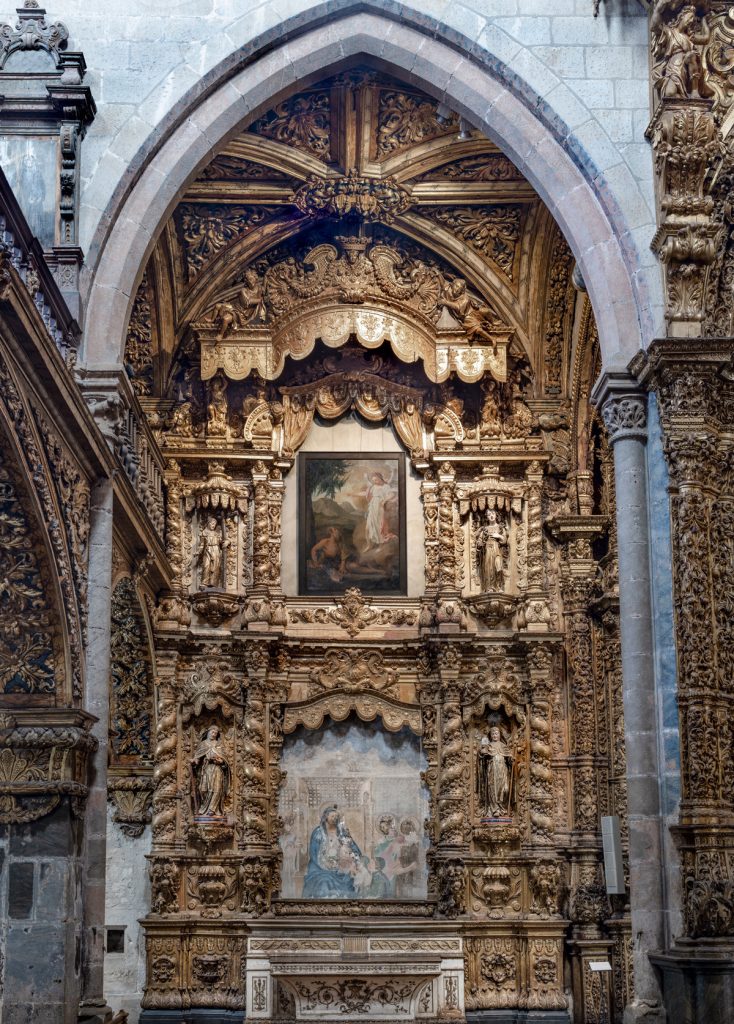
Retábulo de Nossa Senhora da Graça ou da Senhora da Rosa
Altarpiece of Our Lady of Grace or Our Lady of the Rose
Data | Date: 1743
Período/Estilo | Period/Style: Barroco Final ou Joanino; Late Baroque or Joanine
Entalhador | Carver: Manuel da Costa Andrade
Risco | Design: Francisco do Couto e Azevedo

Retábulo encomendado pela Irmandade de Nossa Senhora da Graça, em 1743, a Francisco do Couto e Azevedo e executado pelo entalhador Manuel da Costa Andrade, responsáveis por uma interpretação esmerada da linguagem decorativa exuberante própria do estilo barroco joanino: uma profusão de elementos elegantes e cenográficos preenchem toda a superfície e enquadram a estrutura, os nichos para as esculturas e os vãos centrais onde actualmente se encontram duas pinturas. No centro, no remate do nicho do primeiro andar, surge uma cartela onde se insere o monograma de Maria (AM).
A pintura mural do corpo central inferior data do século XV e está atribuída a António Florentim ou a Álvaro Pires de Évora, tendo sido descoberta numa intervenção de restauro de 1908. Representa a Nossa Senhora com o Menino, tendo a seus pés um casal de doadores, que se pensa serem os reis de Portugal D. João I e D. Filipa de Lencastre, acompanhados por dois santos – São João Baptista e São João Evangelista, santos homónimos do rei. O registo superior é preenchido por uma pintura a óleo sobre tela que representa São Jerónimo anacoreta, mas que não é original do retábulo.
Nos nichos laterais encontramos as esculturas de Santa Isabel e Santa Clara (em baixo) e de Margarida de Cortona e Maria Madalena (em cima).
A mesa de altar foi substituída em época posterior, sendo já de estilo neoclássico.

This altarpiece was commissioned by the Confraternity of Our Lady of Grace in 1743 from Francisco do Couto e Azevedo and executed by the carver Manuel da Costa Andrade. Their painstaking interpretation of the greater decorative exuberance typical of the Joanine Baroque style reveals a profusion of elegant and scenographic elements that fills the entire surface and frames the structure supporting the niches for the sculptures and the central openings where two paintings are currently located. In the centre, above the niche on the first tier, there is a cartouche bearing Mary’s monogram – AM, for Ave Maria.
The 15th-century mural painting in the lower central section is attributed to António Florentim or to Álvaro Pires de Évora, having been discovered during restoration works in 1908. It depicts the Madonna and Child. At their feet stands a donor couple, the commissioners of the painting, thought to be D. João I and D. Filipa de Lencastre, accompanied by two saints, St. John the Baptist and St. John the Evangelist, the king’s namesakes. The upper register is taken up by an oil painting on canvas depicting Saint Jerome the Hermit, but it is not original to this altarpiece.
The side niches contain sculptures of St.Isabel (Queen Isabel) and St.Clare (Santa Clara) in the lower register, with the sculptures of the Franciscan Saint Margaret of Cortona and Mary Magdalene in the upper register.
The altar table was replaced at a later date and is now in the neoclassical style.
